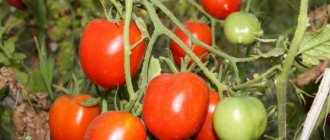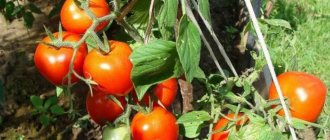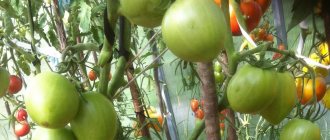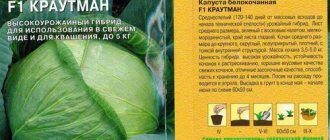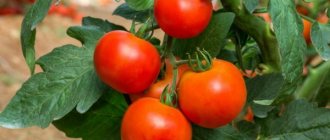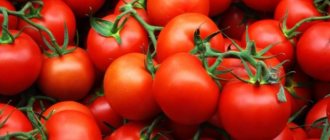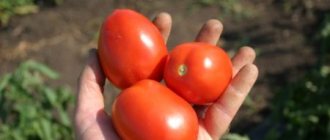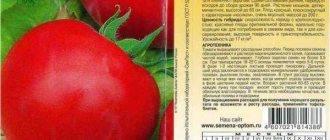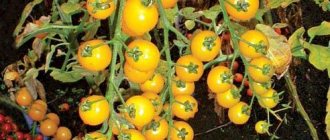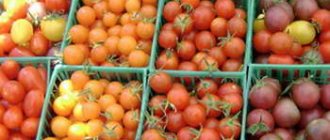What varieties are there?
Tarasenko worked as a physics teacher in the Sumy region of Ukraine, in the village of Voronezh. On his plot, he grew precisely tall indeterminate varieties - De Barao, Limon Liana, Cosmonaut Volkov, etc.
This breeder, of course, was also involved in breeding his own tomatoes. Ultimately, he obtained varieties that are still very popular among summer residents:
- Tarasenko-1, 2 and 3.
- Anniversary Tarasenko.
It is these varieties of the breeder that have earned the greatest recognition from summer residents. This specialist also developed several less popular varieties of tomatoes: Tarasenko-5 and 6, Combitomat Tarasenko, Nadezhda Tarasenko, Legend Tarasenko. These varieties, judging by the reviews of summer residents, also have good yields and are relatively unpretentious. But gardeners still grow them relatively infrequently.
How to grow
This variety is completely unpretentious, but, like all tall and productive tomatoes, Jubilee Tarasenko needs proper care. In the climatic conditions of Russia, tomatoes are grown in seedlings, so you first need to sow the seeds.
Important! A gardener can safely collect seeds from his own tomatoes, because Jubilee Tarasenko is a varietal tomato, its seeds contain complete genetic information. That is, the tomato does not “degenerate” over the years.
Growing seedlings
There is nothing complicated or unusual in growing Tarasenko tomato seedlings: they are grown in the same way as seedlings of other varieties:
- Planting dates depend on the climate in the region. In central Russia, Tarasenko seeds are sown for seedlings at the end of March. You need to focus on the fact that by the time they are transplanted into the ground, the seedlings must be two months old. To grow tomatoes in a greenhouse, seeds should be sown a couple of weeks earlier.
- The soil for tomatoes should be loose and nutritious, it needs to be disinfected. Acidity is preferably low or neutral.
- Seeds should also be disinfected. A pink solution of manganese is suitable for this.
- It would be a good idea to treat the planting material with a growth stimulant. For example, “Immunocytophyte”.
- The seeds are laid out according to a 2x2 cm pattern; they need to be buried 1.5-2 cm. Sprinkle dry soil on top and water with warm, settled water. Cover the box with film and wait for the shoots to appear.
- When the bulk of the seeds hatch, the film is removed. Tomatoes are placed on the windowsill, not far from a radiator or other heat source.
- Tomatoes peak at the stage of a pair of true leaves. Large containers for picking Tarasenko tomatoes are needed, because the roots of the tomato are powerful - 250-300 ml cups are suitable.
Advice! Tomato seedlings of the Yubileiny variety are prone to elongation. To prevent this from happening, you need to illuminate the tomatoes with electric fluorescent lamps.
Planting tomatoes in the ground
Before planting in the garden, tomatoes are usually hardened off. This should be done 10-14 days before the upcoming planting; the temperature is lowered gradually. By the time the seedlings are transferred to the ground, each plant should have 7-8 leaves, and a flower ovary may be present.
The rules for planting Jubilee Tarasenko are as follows:
- In advance, the beds are watered with a solution of potassium permanganate and dug up.
- The holes for tomatoes are made in a checkerboard pattern, the distance between them should be 60-70 cm. The depth of the hole is large - about 30 cm, the diameter is about 15 cm.
- The seedlings are buried down to the first true leaves, sprinkled with soil and the soil is lightly compacted.
- If the tomato is too elongated, it is planted at an angle (you can even put the seedlings on the ground, burying the roots).
- Immediately after planting, tomatoes should be watered with warm water. For the first few days after this, the seedlings are not watered until they become stronger.
Caring for tomatoes Tarasenko
Tomatoes do not require complex care, but all vine-like varieties require special treatment - the gardener must take this into account.
Caring for tomatoes is as follows:
- When the seedlings get stronger and an additional leaf appears on it, it is necessary to tie up the tomatoes. It is better to use a trellis - supports in the form of stakes and wire stretched between them. A rope or thin strip of soft cloth is lowered to each tomato and a stem is tied.
- After watering or rain, the soil must be loosened.
- The bush is formed into one or two stems. The remaining shoots must be removed every 10 days throughout the entire tomato growing season. The length of the stepsons should not exceed 3-4 cm, otherwise their removal will be too traumatic for the plant.
- It is also better to tear off the lower leaves, but do it gradually - removing 2-3 leaves a day.
- About three times during the summer, tomatoes are treated with copper preparations to protect the bushes from fungal infections.
- Regularly water the tomatoes, remove weeds between the rows, and inspect the bushes for pests.
Attention! When the tomato variety Yubileiny Tarasenko grows to 170 cm, its top needs to be pinched, leaving a couple of leaves. If this is not done, the vine will grow up to 300 cm, which will negatively affect the size and quality of the fruit.
It is better to pick tomatoes unripe; they will turn red in a couple of days and will be stored for a long time. The variety is considered a salad variety, but is suitable for almost any purpose.
General description of varieties
A feature of all tomatoes bred by Tarasenko is, first of all, their tallness. Their stems can reach a length of up to 2 m, and in some cases up to 3 m. Therefore, tomatoes of this variety, of course, need a garter.
The root system of tomatoes bred by this breeder can go into the ground to a depth of 1.5 m. Therefore, such tomatoes are planted in open ground using a special technology.
The yield of Tarasenko varieties reaches 10-30 kg of tomatoes per bush. Of course, not a single low-growing tomato can boast of such indicators.
Another feature of the tomatoes bred by this breeder is their long growing season. Tarasenko bred mainly early- or mid-ripening varieties. But summer residents have the opportunity to collect fruits from such tomatoes until frost.
All varieties bred by this breeder produce compact-sized fruits, ideal for canning. The yield of most varieties of this specialist is 20-25 kg per bush.
Characteristics of the bush and subtleties of care
General characteristics and description of varietal characteristics of the Yubileiny Tarasenko tomato are as follows:
The plant is of an indeterminate type, the stems are liana-shaped, of unlimited growth, that is, if the tops are not pinched, it can grow up to 3 meters or more. Therefore, a month before the cold weather, the growth of the stems must be stopped so that new clusters do not form and the ovaries can ripen.
The stem is very powerful, thick, the leaves are large, dark green, without pubescence, and sparsely spaced. Formation should be done in one, maximum two stems. Step-sonning is mandatory.
Support is required regardless of the chosen height; the bush must be tied every 30-40 cm so that heavy brushes do not break the bush. You can use wooden supports for this, tie them to trellises or cucumber mesh.
Each cluster is large, with an amazing number of fruits - up to 30 pieces! And since the weight of individual fruits is from 80 to 130 g, the weight of the brush can reach 3 kg. And from a bush you can collect from 12 to 15 kg of delicious tomatoes. Tarasenko himself said that this is not the limit - in greenhouses he managed to get 30 from a bush with a height of 2.4 m, and in open ground with a height of 1.8 m - up to 20 kg.
Fruiting is extended, the hybrid has a mid-early ripening period, but ripe tomatoes can be harvested until frost, the remainder can be picked off in the milky ripeness phase, which ripen well and are then stored for a month or more. Experienced vegetable growers hang whole clusters of them in the cellar and feast on fresh tomatoes for the New Year.
The plant bears fruit well, regardless of the whims of the weather, and tolerates low temperatures well.
The bush is resistant to almost all types of diseases - diseases and pests are not afraid of it. This allows you to grow environmentally friendly crops, without chemical treatments. However, disease prevention must be carried out using traditional methods.
Pests can affect Jubilee Tarasenko, but mainly in greenhouses, in particular whitefly. Fumigation against midges is required.
If there is excess moisture, tomatoes will not crack. The plantings should be sufficient; in the heat and without water, the bush may shed some of the ovaries, leaving only small fruits.
Description of tomatoes Tarasenko-1
This variety is the earliest of all, bred by a Ukrainian breeder. The fruits of Tarasenko-1 are cream-shaped and have a somewhat ribbed surface. The color of tomatoes of this variety is deep red. Their flesh is dense, juicy and quite sweet. The fruits of Tarasenko 1 can weigh from 70 to 100 g.
The peculiarity of this variety, among other things, is that it is undemanding in terms of sunlight. Moreover, it can be grown both in open ground and in greenhouses. According to summer residents, the fruits of this variety are excellent for making pickles and for fresh consumption.
A few more words about the variety
Yubileiny and other representatives of the Tarasenko variety are suitable for growing in both closed and open soils. Regardless of the choice of growing location, it produces good yields. When finally formed, the culture has 2 stems, the second one is created by parallel pinching. The rest are removed as they appear.
Numerous reviews confirm that the varieties are highly resistant to viruses. The average weight of one fruit reaches about 100 g. Usually vegetables have a classic red color. Some representatives on the fruits have a small nose.
Vegetables are consumed fresh or thermally processed. Tomatoes are suitable for any type of preservation. Suitable for preparing various dishes, where they are used whole or as juice. Can be eaten fresh. Tarasenko is valued for its good taste. Satisfied gardeners note their keeping quality. They can withstand transportation without any difficulties, maintaining good presentation.
Tarasenko is the tomato variety chosen for cultivation. Every year it can be increasingly found in the gardens and greenhouses of many summer residents and gardeners.
What is the Tarasenko-2 hybrid
The peculiarity of this variety is, among other things, that it can reach a height of 2.2 m. The characteristics of Tarasenko-2 tomatoes are simply excellent. They belong to the group of frost-resistant mid-season varieties. The fruits of this hybrid are round with a spout. Their skin and pulp are raspberry-red.
The taste of the fruits of Tarasenko 2, according to many gardeners, is simply excellent. Their flesh is very dense and sweet. It is the fruits of this variety, of all those bred by the Ukrainian breeder, that are considered most suitable for canning.
Like Tarasenko-1, this hybrid can also be grown in a greenhouse. The weight of the fruits of this variety can reach 60-100 g.
Features of varietal tomatoes from the Netherlands
Mazarin tomato reviews - a scam or true?
Nowadays, on store shelves you can find many varieties and hybrids of tomatoes from various manufacturers. A fairly large market share belongs to companies from the Netherlands, for example, Nunhems, Seminis, Syngenta, Bejo. Among imported seeds, they are undoubtedly the leaders.
As an edible crop, tomatoes were not used in Europe until the 18th century, although they were brought from America two and a half centuries before that. As for the Netherlands, despite the heat-loving culture, it quickly took root in this country. Very often, it is for this reason that our gardeners choose Dutch tomato varieties. The Netherlands is a country with a minimum number of sunny days a year, there is very frequent rain, so when crossing, breeders try to develop varieties and hybrids that are resistant to such conditions.
Among Dutch tomatoes there are both those that can be grown in greenhouses and those that are intended for open ground. However, do not delude yourself: for each specific hybrid or variety it is necessary to withstand the conditions for which it was bred. Resistance to diseases is a huge advantage, but many domestic tomatoes tolerate most diseases and viruses well, which makes them no less popular.
Important! When choosing seeds, pay attention to the information on the packaging. For some, ripening time and taste are important, but for others, the safety of tomatoes, the ability to transport them, or even quality such as the height of the bush and the difficulty of caring for the plant are considered more important.
For some, ripening time and taste are important, but for others, the safety of tomatoes, the ability to transport them, or even quality such as the height of the bush and the difficulty of caring for the plant are considered more important.
If you buy seeds of hybrids or varieties in a store, make sure that the information on the packaging is translated into Russian. Important information:
- tomato disease resistance;
- ripening period of tomatoes;
- size of plant and fruit;
- yield per bush or square meter;
- use and taste.
Since competition in the market today is great, new greenhouse farms are built every year, experts advise from time to time to try new breeding products, including imported tomatoes.
Tarasenko-3
This variety also belongs to the mid-season group. Its main advantages include abundant and long-lasting fruiting. These bushes can reach 1.8-2.2 m in height.
The fruits of hybrid tomatoes Tarasenko-3 can have either a plum-shaped or flat-round shape. Their color is bright red. Tomatoes grow quite large on this hybrid. Their weight can be 80-150 g. Tomatoes of this variety are considered suitable both for salads or fresh consumption, and for canning.
Indeterminate varieties
F1 SHARP
Mid-season, vigorous plants. The fruits are large, round in shape, weighing 200-220 g. The color of unripe fruits is light green, and that of mature ones is red. Recommended for extended rotation in greenhouses. The hybrid is genetically resistant to tobacco mosaic virus and verticillium.
F1 EREMA
Mid-season, from germination to first harvest 115-120 days. Plants are 1.5-2.0 m high. The fruits are flat-round, weighing 180-200 g, dense, red when ripe, used for fresh consumption. Recommended for winter-spring regular and extended rotation (ground and low-volume crops). Resistant to tobacco mosaic virus, cladosporiosis, fusarium.
F1 COMMISSIONER
Mid-season, from germination to first harvest 115-120 days. Plants are 1.5-2.0 m high. The fruits are round in shape, weighing 90-100 g, dense, red when ripe, used for fresh consumption and whole-fruit canning. Recommended for winter-spring regular and extended rotation (ground and low-volume crops). Resistant to tobacco mosaic virus, cladosporiosis, fusarium.
F1 LYUBAVA
Mid-season, from germination to the beginning of ripening 115-118 days. Plants over 2 meters high (no growth restrictions). The fruits weigh 110-130 g, round in shape, dense, fleshy, 4-6 chambered. The color of unripe fruits is light green with a dark green spot at the place of attachment of the stalk; When ripe, the fruits acquire an even bright red color. Planting density 2.5-3 plants/sq.m. Designed for growing in spring heated and unheated greenhouses. Advantages of the hybrid: high yield (4.5-5 kg per plant), beautiful large fruits with high commercial qualities.
F1 MASTER
Mid-season, recommended for extended rotation (ground and low-volume crops). The fruits are large, round in shape with a smooth surface. The color of unripe fruits is uniform, light green, while that of mature fruits is red. The average fruit weight is 220-250 g. The hybrid is genetically resistant to tobacco mosaic virus and verticillium.
F1 MANECHKA
Medium early, from germination to first harvest 110-115 days. The fruits are flat-round in shape, weighing 120-140 g, dense, slightly ribbed, red when ripe, for salad purposes. Recommended for growing in spring-summer rotation in protected ground (to the south - in open ground). Resistant to tobacco mosaic virus.
F1 NAVIGATOR
Mid-season hybrid for extended rotation (ground and low-volume crop). The plants are powerful and vigorous. The fruits are round in shape with a smooth surface, weighing 200-215 g. The color of unripe fruits is dark green without a spot, and the color of mature ones is red. The hybrid is genetically resistant to tobacco mosaic virus and verticillium.
F1 FLUTE
Mid-season: from germination to first harvest 115-120 days. The fruits are round in shape, weighing 120-150 g, dense, red when ripe, used for fresh consumption and whole-fruit canning. Recommended for winter-spring regular and extended rotation (ground and low-volume crops). Resistant to tobacco mosaic virus, cladosporiosis, fusarium.
ROSINA
Mid-early variety; from germination to ripening 100-115 days. The plants are vigorous. The fruits are large, flat-round, weighing 160-300 g, slightly ribbed, 3-4 or more chambered. Unripe fruits are green, with a spot at the place of attachment of the stalk, which disappears when ripe, mature ones are pink. Planting density – no more than 2.5 plants/sq.m. Designed for cultivation in protected soil. Advantages of the variety: weak fruit cracking compared to other pink-fruited tomatoes.
DESSERT
Early ripening, from germination to ripening 95-100 days. Plants are indeterminate, tall. The fruits are very small, weighing about 20 g, round, with a smooth surface, two-chambered, unripe - whitish-green, without a spot on the stalk, ripe - red. Designed for cultivation in film greenhouses and in open ground, but with a mandatory tie to a support. Resistant to tobacco mosaic virus. Planting density 3 plants/sq.m. Advantages of the variety: exceptionally high taste of the fruit, suitability for canning.
Description of the variety Yubileiny Tarasenko
The Ukrainian breeder developed this tomato for his 75th birthday. Hence the name of the hybrid. The main distinguishing feature of this variety is its tallness. Jubilee Tarasenko is the most powerful variety of all bred by the breeder. The height of bushes of this variety can reach 3 m. Below the reader can see these Tarasenko tomatoes in the photo. This variety also received excellent reviews from summer residents.
A feature of Yubileiny Tarasenko is also a low degree of foliage. Bushes of this variety are well ventilated during cultivation, which minimizes the risk of developing infectious diseases.
The fruits on Jubilee Tarasenko's tomatoes grow quite large. Their weight can be 80-200 g. Tomatoes of this variety have a round or heart-shaped shape. The pulp of the Yubileiny fruits is fleshy and very tasty.
Summer residents consider uneven ripening of the fruits to be some of the disadvantages of this variety. At the end of the season, Yubileiny Tarasenko’s tomatoes often have to be picked, unfortunately, unripe. This variety is intended mainly for growing in a greenhouse. But if you wish, you can plant such tomatoes in open ground.
Varieties of the variety and their description
Feodosius Tarasenko developed his own agricultural technology for growing tomatoes, which promotes long-term fruiting and increased productivity. Varieties bred in Ukraine are taking root and delighting gardeners in Karelia, gardeners in Siberia, and farmers in the southern regions of Russia with a tomato harvest.
Hybrid Tarasenko 1
The first representative of the series, created by an amateur vegetable grower, is distinguished by its early ripening. Tomato bushes with strong roots grow up to 2 m in height. Ribbed cream has a rich classic color, one tomato weighs about 75 g, and larger specimens are also found. The variety was bred for planting in a greenhouse, where it produces high yields, but cannot withstand temperature fluctuations and is demanding on lighting.
Hybrid Tarasenko 2
Many summer residents, having planted this tomato for testing, every year buy its seeds at the kiosks for sowing, despite the fact that the bushes need to be tied up like a vine and stepsoned. One bunch of plants produces up to 4 dozen tomatoes, which is more than 2 kg. The fruits are valued:
- for excellent taste;
- delicate aroma;
- original form;
- excellent keeping quality.
Round tomatoes have smooth skin, a cute nose, and canned whole, since they weigh no more than 70 grams. After heat treatment, tomatoes do not burst and can hang on the branches for a long time without spoiling at all.
Hybrid Tarasenko 3
When properly formed, the tomato, whose height approaches one and a half meters, surprises with huge clusters with a large number of fruits weighing about 200 g, ripening in the middle period. Tomatoes have an interesting cube shape, a dense consistency, and there are no voids in the pulp. The fruits are fermented in barrels, sealed in jars, and used to make juice. Even after heat treatment they are cut into even slices. The variety is immune to fungal infections and is not affected by viruses.
Hybrid Tarasenko 5
In creating this mid-season tomato, Feodosius Makarovich used the Raketa variety, known at that time. On powerful bushes about 2.5 m high, tomatoes of a beautiful oblong shape are tied in clusters. The fruits, which weigh about 100 g, are harvested 108 days after planting in the ground.
See also
Characteristics of the Gilgal tomato and agricultural technology for cultivating the hybrid
Read
Hybrid Tarasenko 6
The mid-early variety is valued for its resistance to fungal and bacterial infections and drought; in the southern regions it is grown without seedlings. Strong tomato bushes are slightly taller than a meter, but this is not an obstacle to excellent productivity. Bright red tomatoes weigh more than 300 g, have a round shape, are stored for a long time, and are not damaged during transportation.
Hybrid Tarasenko 6
A tomato of a determinate variety does not stretch upward, but grows as a bush, which still has to be tied up, since about 1 kg of fruit ripens on one bunch. Gardeners value them for their real tomato taste. The tomato does not suffer from diseases, tolerates unfavorable conditions, a large number of ovaries appear even in dry and hot weather. It is interesting that on one plant fruits ripen of approximately the same weight, about 100 g, but of different colors and shapes. Both pink and red tomatoes, elongated and round, are picked from the bush.
Tarasenko Yubileiny
Feodosius Makarovich began creating vegetable crops when he was already over 40. For his 75th birthday, the amateur developed a unique tomato, the powerful root of which grows not in depth, but in width. The weakly leafy branches of the bush stretch up to 3 meters. The main stem produces 5 racemes with a large number of flowers. Such a bunch of fruit weighs up to 5 kg. Large heart-shaped tomatoes are valued for their juicy, sweet pulp and resistance to cracking. They ripen unevenly, ripen well indoors, and are stored for a long time.
Landing Features
The technology for growing tomatoes of the Tarasenko variety is somewhat different from the methods for cultivating most other varieties of tomatoes. Summer residents usually prepare pits for these varieties in the fall. At the same time, they dig them out with dimensions of 50x50 cm and a depth of 40 cm.
The pits are placed on the site in a checkerboard pattern. The distance between them in the row is left at 1 m. The row spacing is made 1.5 m wide.
Seedlings of these tomatoes are grown in the usual way. Seeds are sown in deep boxes at the end of March. During the growing process, seedlings are watered in time and the soil under them is loosened. It is permissible not to pick Tarasenko tomatoes.
Seedlings of this variety are planted in prepared holes at an age of at least 60 days. Before planting, humus, a little wood ash and mineral fertilizers are added to the holes. Two plants are planted in each such hole. The first watering of seedlings transferred to a permanent place is carried out with warm water with potassium permanganate dissolved in it (3 g per 10 liters).
Tarasenko hybrids (various)
here
https://hobby.nikolaev.com.ua/05/modules.php?name=Articles_spokes&file=view&articles_spokes_id=61
Much has been written about these hybrids.
Liana-shaped pearls of Polesie (November 2006)
In order to always have a harvest, in addition to high agricultural technology, you also need varieties adapted to the weather conditions of a given region.
Breeder Tarasenko Feodosiy Makarovich lived and worked in the village of Voronezh, Shostkinsky district, Sumy region. He grew about 50 varieties, including domestic selection Gigant 40, Kabardinsky, Cosmonaut Volkov, from foreign De Barao, Crop Prince, Lemon Liana, Bulgarian Pearl, and varieties of his own selection Hybrid 1, Hybrid 2, Hybrid 5, Hybrid 6 ,Polessk giant, Gift to Polesie, Anniversary Tarasenko. All his varieties are tall and indeterminate. Liana-like ones differ from ordinary low-growing ones in all respects. They are high-yielding (from 10 to 30 kg per bush, and more!), Their fruits have high taste. The growing season and fruiting period are significantly extended; until the autumn frosts, the bushes will delight you with their delicious tomatoes if you decide to give preference to these varieties. I have been practicing planting these varieties on my plot for several years now. And the family is happy. I also gave some seeds to my friends and they don’t complain. Liana-like ones are more resistant to diseases. Their fruits are tasty not only fresh, but also pickled, marinated, or canned. Perfect for winter seaming De Barao, Hybrid 2, Lemon Liana. In addition, these varieties can be stored fresh until January. Beautiful tomatoes will decorate your New Year's table, such a surprise from your own dacha.
F. M. Tarasenko developed the special care and agricultural technology that these productive giants require. The root system of tall tomatoes penetrates deep into the soil, sometimes up to 1.5 and even 2 meters. Therefore, it is necessary to create optimal conditions for the development of powerful roots for the plant, starting from sowing the seeds.
As a rule, seedlings are planted at two months of age. Before planting seedlings, prepare pits 50x50 cm and up to 40 cm deep. The distance between the pits in the center is up to 1 m, between rows is 1.5 meters. The top layer of soil is folded in one direction, the bottom layer in the other. Fill each hole with two buckets of humus, 3 - 4 cups of wood ash and 50 g of complex mineral fertilizer and mix thoroughly with the top layer of soil. It is also advisable to prepare the pits in the fall. Plant the seedlings in the peat pots in which they were grown before planting. Plant two plants in the hole, and then form a bush in a two-stem form.
Water the planted plants generously with heated water, having previously dissolved potassium permanganate in it (3 g per 10 liters of water). As the plant grows, it needs to be pinched, leaving one or two stepsons for fruiting, tying them to a support. The most successful trellis method of gartering to supports, in which each stem and each fruit bunch is well illuminated by the sun and ventilated, the stems do not oppress each other. At the same time, if a stake is driven into the hole and tied to it, the plant overcomes the crowding of the bush, the drying of rainwater and dew is delayed, and the accumulation of excess moisture contributes to the spread of fungal diseases and especially late blight. Watering should be done with water heated in the sun, once a week (7-10 liters per bush). After watering and rain, you need to loosen the soil around the plants. 10-12 days after planting, the plants are fed, if there are no organic fertilizers, then with mineral fertilizers, dissolving 20 g of carbamide, 60-80 g of superphosphate and 40-50 g of potassium salt in 10 liters of water.
Potassium chloride or other chlorine-containing fertilizers should not be applied to tomatoes. It is necessary to feed them a second time after the formation of fruits and a third time after 12 - 18 days. During the second and third feeding, nitrogen fertilizers are not applied so as not to worsen the conditions for fruit ripening and to prevent the accumulation of nitrates in them.
During rainy periods with low temperatures, preventive spraying with one percent Bordeaux mixture (100 g of copper sulfate and 100 g of lime per 10 liters of water) should be carried out every 7-10 days.
As the tomatoes set, the leaf under the fruit must be removed.
You will have to tinker with liana-shaped tomatoes. But they're worth it. Agree that it’s not bad to get 20 - 30 kg of quality fruits from one bush. If you make a frame 50 cm high at the base of the bush and fill it with a mixture of humus and soil, then the yield will increase twofold or more. I have outlined the agricultural technology used by Feodosius Makarovich Tarasenko. Despite the vagaries of the weather, he always had tomatoes. Particularly valuable for Polesie are the local varieties that were bred by F. M. Tarasenko.
At one time I was in friendly correspondence and exchanged varieties with him. Anyone interested in liana-like varieties, write to me. I have seeds of these varieties for sale. My tomato seeds undergo a “course” of charging with the energy of the pyramids. Small copies of the Cheops pyramids are right in my apartment. It's a wonderful thing. Tomato seeds treated in them produce plants whose yield increases by 60%, they do not suffer from late blight, and are also more resistant to adverse weather conditions.
HYBRID 1.
Hybrid 1 has round, smooth, fleshy, orange-red fruits weighing 200 - 300 g. Feodosius Makarovich called his varieties Hybrids. But in fact, these varieties have been gaining fame for decades. V.I. Rosly reports that he grows Tarasenko hybrids in a greenhouse under a film, the fruits are large, beautiful, and tasty. From one bush the harvest is from 14 to 20 kg. So what can we say about our region if this avid gardener grows his tomatoes much further north.
HYBRID 2.
Vigorous, relatively cold-resistant. The fruits have dense, tasty pulp, have the shape of a blunt body with a retracted top (budenovochka), orange-red color, weighing 50 - 70 g, and are stored for a long time. The clusters are very complex, multi-fruited, each cluster contains 30 - 40 fruits with a total weight of 2 - 3 kg. The fruits can be eaten fresh, canned and stored for a long time, followed by ripening. The highest yield is produced by this crop in 2 - 3 stems - 15 - 20 kg of fruit per bush. It is advisable that the gardener regulate the number of fruits in the cluster, removing poorly developed buds and flowers.
HYBRID 5 AND HYBRID 6.
The varieties are indeterminate, mid-early, from germination to the first harvest it takes 108 - 107 days. The bush is medium-leaved, 2 - 2.5 meters high. Tied to a trellis. The brush is simple, with one branch. It grows 4 - 5 large, oval-flattened, smooth fruits, red in color, up to 500 g. The pulp is dense, has good taste, and is intended for salad purposes.
HOPE.
Tall (up to 4 meters). This bush should be formed into two stems. Each one is tied with 5 - 7 bunches weighing 1.5 - 2 kg. The fruits have an oval-elongated shape (6x3), with an average weight of 80 - 100 grams. Individual clusters have 30 or more fruits. The fruits are fleshy, with high taste. They have a peculiar coloring. Before full ripening, the top becomes yellow-green, which gradually turns orange, and the rest of the fruit is red. Stored indoors until January.
COMBITOMATH.
The variety is indeterminate. From germination to the first harvest of ripe fruits, 102 days pass. The bush is slightly leafy, 2 or more meters high. The first bunch is planted after the 9th leaf, the subsequent ones every 3 leaves. The cluster is complex, with 15 - 20 or more flowers. The fruits are oval-elongated, plum-shaped, red, weighing 100 - 200 g. The pulp is light red, dense, of good taste. The total yield per bush is 15 - 20 kg, and with a frame up to 30 - 35 kg.
GIFT TO POLESIA.
The fruits of this variety are orange-red in color. The shape is rounded, flattened, ribbed. Weight up to 300 - 500 g. The pulp is dense, fleshy, excellent taste.
ANNIVERSARY TARASENKO.
This variety was bred by Feodosius Makarovich in 1987 just in time for his 75th anniversary, hence the name. This is a tall variety. Its main stem grows up to 3 meters, weakly leafy. By the end of the season there are 4 - 5 clusters on the main stem. The first bunch is laid over 3 - 4 leaves, the subsequent ones - after 1 - 2 leaves. Sometimes a second cluster forms after the first. Complex inflorescences bear 300 or more flowers, but the ovaries on them are not formed simultaneously and not on all of them. The first ovaries appear at the base, then in the center of the inflorescence, and then fruit set gradually occurs at the periphery. The fruits are round, some are flat-round, and vary in size. The weight of the tomato is 180 - 200 g, the large ones have slight ribbing in the calyx area, their top is slightly pulled back. These fruits are orange-red in color, smooth, fleshy, 6-8 chambered, of good taste. They are suitable for fresh consumption, good in salads, and used for preparing for future use. They retain their commercial qualities for one to one and a half months. The first bunches of Yubileiny reach 4 - 4.5 kg.
Developmental care
During the growth stage, tomatoes of this variety must be planted. Otherwise, few ovaries will form on the bushes. Most often, Tarasenko tomatoes are grown using the two-trunk method. When using this technology, you can get maximum yields from the bushes.
During development, each plant should be well ventilated and illuminated. As already mentioned, trellises are arranged in the area with these tomatoes. As tomatoes of these varieties set fruit, the lower leaves should also be removed.
Valentina Redko, collector from Kurgan
Slastena is a medium-sized early variety of tomatoes. My annual leader in yield. When formed in a greenhouse in 3-4 stems, it gives maximum yield. The fruits are red, round in shape, weighing 150-300 g, and in the first bunches they can weigh up to half a kilogram! The tomatoes are fleshy, the pulp is sugary, “watermelon” type, juicy, very sweet. The variety is very productive - the fruits grow in clusters of 5-8 pieces. Can be grown in a greenhouse or open ground.
Babushkino is a tall, mid-early variety. The bush is spreading. Formation of 3 stems in a greenhouse. The fruits are flat-round, pink-red in color (red on the outside, pink on the inside), with an average weight of 300-400 g (the first fruits up to 700 g), fleshy. The pulp is oily, juicy, very sweet. The skin is thin. This variety is ideal for salads. The yield is amazing - there are up to 12 fruits in a cluster, equal in size and shape. Grows well both in greenhouses and in open ground.
Watermelon (Watermelon, USA) is a tall variety of medium-early ripening. Potato type leaf. The fruits are flat-round, raspberry in color, with an average weight of 300-400 g, fleshy, fragrant, very sweet. There are few seeds in the fruit. To obtain the maximum yield, the bush must be formed into 3 stems with a mandatory good garter (since the weight of the harvest can break the trunks) and maximum removal of excess leaves. This variety is also my annual leader in yield. Grows better in a greenhouse.
Feeding and watering
Tarasenko himself recommended fertilizing these varieties three times per season. For the first time, organic matter or complex mineral compositions are applied to the plants two weeks after planting. The second time, Tarasenko varieties are usually fertilized during the period when the first fruits appear. Approximately 20 days after this, a third feeding is carried out.
Tarasenko's tomatoes are supposed to be watered once every two weeks. In arid regions, this procedure can be carried out more often. In any case, 7-10 liters of water should be poured under each plant when watering. The next day after moistening, the soil under Tarasenko tomatoes should be loosened. At the same time, weeds must also be removed from under the bushes.
Features of growing Nizami tomato, planting and care
Sowing the seeds of this variety of tomatoes for seedlings is carried out 60-65 days before the intended planting in the ground. Seedlings dive at the stage of two true leaves. When planting seedlings in a permanent place per 1 sq. It is recommended to place up to 3 plants per meter of land; when forming into 1 stem - up to 4.
Further care for tomatoes consists of timely watering, fertilizing with complex mineral fertilizer, pinching and preventive measures to protect against diseases and pests.
This is a natural variety of tomato. Therefore, we recommend taking seeds from a ripe fruit and using them for planting in subsequent seasons.
When growing tomatoes in a greenhouse, we recommend installing a drip irrigation system - this will save your time and effort, as well as increase plant productivity and reduce the risk of late blight.
Other interesting varieties of tomatoes with photos, descriptions and reviews from gardeners can be found in our Tomato Catalog. Enjoy watching.
If you grew Nizami tomatoes, please write whether you liked them or not. What was the yield and taste of the fruits like under your climatic conditions? How do you rate the disease resistance of this variety? If possible, attach a photo of your tomatoes to your comment. Thank you!
Your reviews of the Nizami tomato and additions to the description will help many gardeners evaluate this variety more objectively and decide whether it is worth planting or not.
Disease Control
In this regard, Tarasenko tomatoes usually do not cause any trouble for gardeners. Most of these varieties are highly resistant to both fungal and bacterial diseases. Summer residents who grow Tarasenko varieties usually do not carry out preventive spraying.
The breeder himself advised performing this procedure only during periods of summer cold and prolonged rains. In such weather, it is useful to treat Tarasenko tomatoes with ordinary, home-prepared Bordeaux mixture (1%).
Tomatoes Tarasenko: reviews from summer residents
Gardeners, both Ukrainian, Russian or Belarusian, have a very good opinion about these tomatoes. First of all, the owners of suburban areas praise, of course, the excellent qualities of Tarasenko’s fruits. Since their flesh is dense, they are transported absolutely without any problems.
The same applies to canning tomatoes of this variety. In jars, these tomatoes do not burst and look neat and appetizing. The taste qualities of the fruits of these varieties have earned only good reviews. The pulp of all these tomatoes, as gardeners note, is pleasant - sweet with sourness.
Summer residents also have absolutely no complaints about the yield of these varieties. According to this indicator, Tarasenko tomatoes are superior to most modern liana-like varieties. These tomatoes do not cause any particular trouble for gardeners. At the same time, summer residents have the opportunity to collect a very large number of fruits from them.
Pink varieties of tomatoes
The following varieties of pink tomatoes are popular:
Tomato Tomato
Demidov. Fruits from 150 to 200 g. Produces stable yields of large fruits. Very good for open ground.
O-la-la and Pink Raffaello. Round, deep pink tomatoes weighing up to 150g. They have excellent product and taste qualities.
My family. Bushes up to 120 cm. Pink-raspberry. Large tomatoes weighing up to 600g. The soft flesh, like a melon, is delicious.
Nice guy. Round fruits weighing up to 150g, rich pink color. Early ripening. The fruits do not crack.
Moscow pear. The fruits are elongated and resemble peppercorns. Very beautiful commercial vegetables.
Petrusha is a gardener. Elongated tomatoes weighing up to 200g.
Supermodel. Delicious, smooth fruits, uniform in color.
Pink Stele. Low bushes. Pink-raspberry elongated tomatoes. Each weight is up to 200g. High yield and excellent taste.
Scarlet Candles. Pink cylindrical tomatoes. You can see them in the photo of tomato varieties.
Slav. Fairly tall plants. Elongated tomatoes, weighing up to 170g. Pink. They have sweet and tasty pulp. Used in salads and canned. Produces stable yields in any weather and is resistant to diseases.
Monastic meal. Tall bushes. Large fruits up to 350 g.
Dad. Large, pink heart-shaped fruits. Unpretentious variety. Early ripening. Delicious tomatoes.

